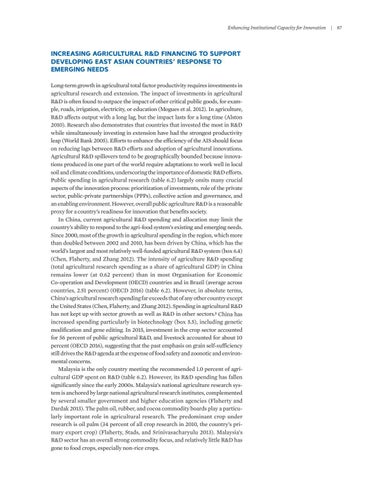Enhancing Institutional Capacity for Innovation | 87
INCREASING AGRICULTURAL R&D FINANCING TO SUPPORT DEVELOPING EAST ASIAN COUNTRIES’ RESPONSE TO EMERGING NEEDS Long-term growth in agricultural total factor productivity requires investments in agricultural research and extension. The impact of investments in agricultural R&D is often found to outpace the impact of other critical public goods, for example, roads, irrigation, electricity, or education (Mogues et al. 2012). In agriculture, R&D affects output with a long lag, but the impact lasts for a long time (Alston 2010). Research also demonstrates that countries that invested the most in R&D while simultaneously investing in extension have had the strongest productivity leap (World Bank 2005). Efforts to enhance the efficiency of the AIS should focus on reducing lags between R&D efforts and adoption of agricultural innovations. Agricultural R&D spillovers tend to be geographically bounded because innovations produced in one part of the world require adaptations to work well in local soil and climate conditions, underscoring the importance of domestic R&D efforts. Public spending in agricultural research (table 6.2) largely omits many crucial aspects of the innovation process: prioritization of investments, role of the private sector, public-private partnerships (PPPs), collective action and governance, and an enabling environment. However, overall public agriculture R&D is a reasonable proxy for a country’s readiness for innovation that benefits society. In China, current agricultural R&D spending and allocation may limit the country’s ability to respond to the agri-food system’s existing and emerging needs. Since 2000, most of the growth in agricultural spending in the region, which more than doubled between 2002 and 2010, has been driven by China, which has the world’s largest and most relatively well-funded agricultural R&D system (box 6.4) (Chen, Flaherty, and Zhang 2012). The intensity of agriculture R&D spending (total agricultural research spending as a share of agricultural GDP) in China remains lower (at 0.62 percent) than in most Organisation for Economic Co-operation and Development (OECD) countries and in Brazil (average across countries, 2.51 percent) (OECD 2016) (table 6.2). However, in absolute terms, China’s agricultural research spending far exceeds that of any other country except the United States (Chen, Flaherty, and Zhang 2012). Spending in agricultural R&D has not kept up with sector growth as well as R&D in other sectors.9 China has increased spending particularly in biotechnology (box 5.5), including genetic modification and gene e diting. In 2015, investment in the crop sector accounted for 56 percent of public agricultural R&D, and livestock accounted for about 10 percent (OECD 2016), suggesting that the past emphasis on grain self-sufficiency still drives the R&D agenda at the expense of food safety and zoonotic and environmental concerns. Malaysia is the only country meeting the recommended 1.0 percent of agricultural GDP spent on R&D (table 6.2). However, its R&D spending has fallen significantly since the early 2000s. Malaysia’s national agriculture research system is anchored by large national agricultural research institutes, complemented by several smaller government and higher education agencies (Flaherty and Dardak 2013). The palm oil, rubber, and cocoa commodity boards play a particularly important role in agricultural research. The predominant crop under research is oil palm (34 percent of all crop research in 2010, the country’s primary export crop) (Flaherty, Stads, and Srinivasacharyulu 2013). Malaysia’s R&D sector has an overall strong commodity focus, and relatively little R&D has gone to food crops, especially non-rice crops.

